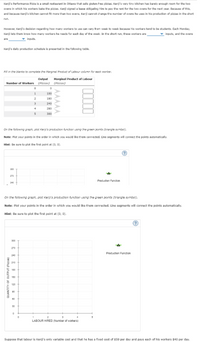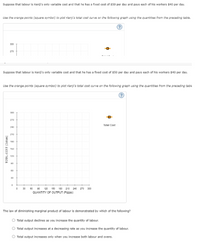
Kenji's Performance Pizza is a small restaurant in Ottawa that sells gluten-free pizzas. Kenji's very tiny kitchen has barely enough room for the two ovens in which his workers bake the pizzas. Kenji signed a lease obligating him to pay the rent for the two ovens for the next year. Because of this, and because Kenji's kitchen cannot fit more than two ovens, Kenji cannot change the number of ovens he uses in his production of pizzas in the short run.
However, Kenji's decision regarding how many workers to use can vary from week to week because his workers tend to be students. Each Monday, Kenji lets them know how many workers he needs for each day of the week. In the short run, these workers are ______ (VARIABLE or FIXED) inputs, and the ovens are ______ (VARIABLE or FIXED) inputs.


Trending nowThis is a popular solution!
Step by stepSolved in 2 steps

- The following graph plots the marginal cost (MC) curve, average total cost (ATC) curve, and average variable cost (AVC) curve for a firm operating in the competitive market for jumpsuits.arrow_forwardThis question deals with cost curves Keep in mind that the formula for a firm's cost function is: TC= FC + C(Q) TC → Total Costs: FC →Fixed Costs: C(Q) → Cost of production*Quantity produced → also known as Variable Costs Q1: Firms A and B are two firms supplying products in two separate differentiated goods markets. Equations (1) and (2) give the total cost functions of the two firms: - Firm A: TC = 2Q --- Equation (1) - Firm B: TC = 10 + 2Q --- Equation (2) Each firm has the ability to produce a maximum quantity of 80,000 units in ten batches of 8,000. The cost per unit in each firm is $2. Firm B has a fixed cost of $10. (a) Explain the relationship between the zero-profit curve and the marginal cost curve for the two firms using the quantity schedule of the two firms and the relevant plots of equations (1) and (2).arrow_forward#2arrow_forward
- Suppose that Maria is starting a food ordering and delivery company. Customers order meals online. Employees prepare the meals and deliver them to customers. Maintenance of the online platform for ordering meals costs the company $5/day. The company also rents spave where orders are prepared. Rent costs $50/day. To make the deliveries, the business also rents two delivery cars the cost $10/day. The costs of ingredients for preparing different numbers of meals are probided in the table below. Maria also has to hire between 0-10 workers to buy ingredients, prepare meals, and deliver the orders. She pays them $120/day. The first two columns of the table below shows how many meals different number of workers can prepare and deliver. Fill out the tablearrow_forwardIn 1939, the box office records set by Gone with the Wind and The Wizard of Oz proved to Hollywood studios that investing in Technicolor was worth every penny. Nevertheless, a reversal of fortune hit the film industry as the United States entered World War II. Wartime shortages made celluloid nitrate more costly, so Hollywood studios reverted to primarily black and white. The few Technicolor musicals released only recovered their production costs. The graph shows Metro-Goldwyn-Mayer's (MGM) production of Technicolor movies before World War II. Modify the graph to describe the wartime period for MGM. Assume that nothing changes except the items discussed in the question.arrow_forwardThe manager of a large apartment complex knows from experience that 100 units will be occupied if the rent is 414 dollars per month. A market survey suggests that, on the average, one additional unit will remain vacant for each 9 dollar increase in rent. Similarly, one additional unit will be occupied for each 9 dollar decrease in rent. What rent should the manager charge to maximize revenue?arrow_forward
- A movie theater shows films for a community of 10000 people. Right now, the price per ticket is $17.50. In the past, when they increased or decreased the price per ticket, they discovered that for every dollar (or fraction) that the price was increased or decreased, the attendance decreased or increased proportionally by 200 people. The theater owner pays the Film Distribution Company $10 (incremental cost) in royalties per person whoviews the film. Find a. The willingness to pay distribution of the movie goers. b. The average price they would be willing to pay. c. The price per ticket that maximizes revenue. d. Should the theater owner increase or decrease the price per ticket if she wants to maximize contribution? e. Find the consumer surplus if the tickets are priced at the price that maximizes contribution. Please complete in excel showing formulas on how it was completedarrow_forwardSuppose that in 2018, you inherited from your grandfather a small planetarium that had been closed for several years. Your planetarium has a maximum capacity of 75 people and all the equipment is in working order. You decide to reopen the planetarium on the weekends as a new laser-tag venture called Shoot for the Stars, and much to your delight it has become an instant success, with admission tickets selling out quickly for each day you are open. Describe some of the decisions that you must make in the short run. What might you consider to be your “fixed factor”? What alternative decisions might you be able to make in the long run? Explainarrow_forwardOnly typed answerarrow_forward
- this table is trickyarrow_forwardAs distance to the city center increases, an office firm’s willingness to pay for space [increases / decreases / remains] at a(n) [increasing / decreasing / constant] rate.arrow_forwardYou and your friends love to go fishing. There is a sporting goods store in your neighborhood that sells a fishing pole for $82 but costs the store $60, and a fully stocked tackle box that sells for $58 but costs $40. Assuming the mark-up policy is linear, determine the equation that relates price (P) to cost (C). Following this same mark-up policy for other items, what would be the price of a pair of waders which cost the company $80?arrow_forward

 Principles of Economics (12th Edition)EconomicsISBN:9780134078779Author:Karl E. Case, Ray C. Fair, Sharon E. OsterPublisher:PEARSON
Principles of Economics (12th Edition)EconomicsISBN:9780134078779Author:Karl E. Case, Ray C. Fair, Sharon E. OsterPublisher:PEARSON Engineering Economy (17th Edition)EconomicsISBN:9780134870069Author:William G. Sullivan, Elin M. Wicks, C. Patrick KoellingPublisher:PEARSON
Engineering Economy (17th Edition)EconomicsISBN:9780134870069Author:William G. Sullivan, Elin M. Wicks, C. Patrick KoellingPublisher:PEARSON Principles of Economics (MindTap Course List)EconomicsISBN:9781305585126Author:N. Gregory MankiwPublisher:Cengage Learning
Principles of Economics (MindTap Course List)EconomicsISBN:9781305585126Author:N. Gregory MankiwPublisher:Cengage Learning Managerial Economics: A Problem Solving ApproachEconomicsISBN:9781337106665Author:Luke M. Froeb, Brian T. McCann, Michael R. Ward, Mike ShorPublisher:Cengage Learning
Managerial Economics: A Problem Solving ApproachEconomicsISBN:9781337106665Author:Luke M. Froeb, Brian T. McCann, Michael R. Ward, Mike ShorPublisher:Cengage Learning Managerial Economics & Business Strategy (Mcgraw-...EconomicsISBN:9781259290619Author:Michael Baye, Jeff PrincePublisher:McGraw-Hill Education
Managerial Economics & Business Strategy (Mcgraw-...EconomicsISBN:9781259290619Author:Michael Baye, Jeff PrincePublisher:McGraw-Hill Education





